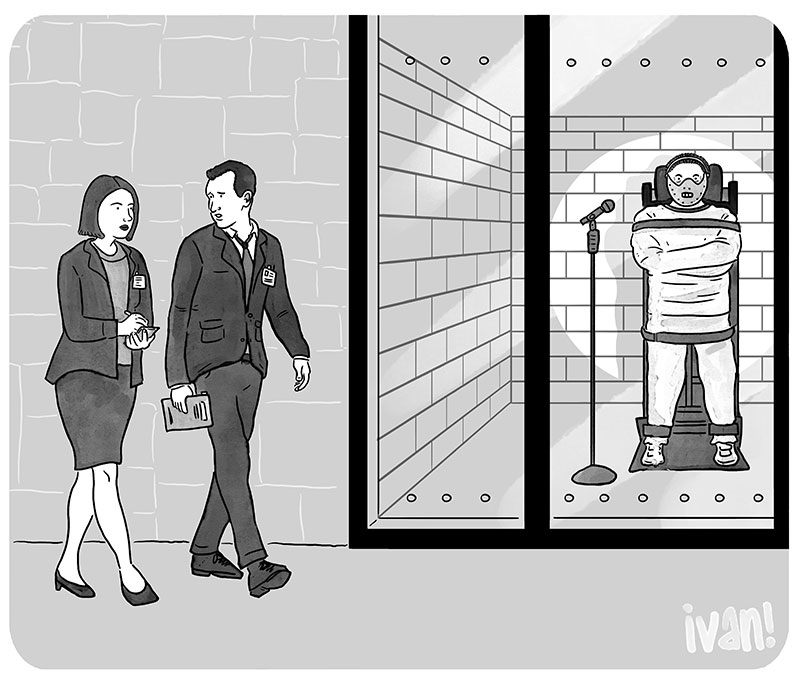 The Silence of the Lambs is an iconic horror movie, the only one to win an Academy Award for Best Picture, and its most striking image—an incarcerated Hannibal “The Cannibal” Lecter in full restraints—is the apparent inspiration for Ivan Ehler’s drawing. Lecter is in his prison cell, and he’s been propped up in front a microphone. FBI agents Clarice Starling and Jack Crawford are walking toward this cell, and Crawford is saying something to Starling.
The Silence of the Lambs is an iconic horror movie, the only one to win an Academy Award for Best Picture, and its most striking image—an incarcerated Hannibal “The Cannibal” Lecter in full restraints—is the apparent inspiration for Ivan Ehler’s drawing. Lecter is in his prison cell, and he’s been propped up in front a microphone. FBI agents Clarice Starling and Jack Crawford are walking toward this cell, and Crawford is saying something to Starling.
My first two captions presume that Lecter is awaiting execution:
- “Don’t ask him what he wants for his last meal.”
- “He’s requested a truly disgusting last meal.”
A similar joke alludes to the time Lecter bragged to Starling about eating a Census Taker’s liver: “For his last meal, can we substitute calf’s liver?”
I then tried to account for the presence of the microphone by turning Lecter into an aspiring comic:
- “His act is mostly gallows humor.”
- “His material is very dark.”
- “He wants to kill on stage, too.”
- “He likes to kill, in both senses of the word.”
- “That’s not funny. That’s sick.”
And finally, I made an obvious pandemic joke: “At least he’s wearing a mask.”
Now let’s see how you did.
Several of you posited that the prisoner is not Hannibal Lecter but another, and potentially more dangerous, psychotic:
- “Always refer to him as ‘Mr. President.’”
- “It was the only way we could stop his tweeting.”
- “Maybe, just this once, the press conference will go well.”
- “We finally got the President to wear a mask.”
- “We’re trying to stop the President from sabotaging his own campaign.”
One of you put a hopeful spin on the Trump jokes by predicting that he won’t get a second term: “This is his first interview since he lost the election.”
Like I did, many of you explained the presence of the microphone by turning Lecter into a stand-up comic:
- “He specializes in ‘sick’ humor.”
- “I suggest you laugh at all his jokes.”
- “You should see what he does to hecklers.”
- “This guy has killer material.”
- “He kills on stage…And off.”
- “Yeah, what is the deal with prison food?”
Like the last set of entries, these puns presume Lecter has a second career as a comedian:
- “His humor can be pretty biting.”
- “His bit is worse than his bite.”
- “He puts the laughter in slaughter.”
That last entry is clever, but it doesn’t sound quite right because such jokes usually rely on words that actually rhyme. Still, I like it.
The next two captions play on the double meaning of a word that describes a banquet at which the guest-of-honor is subjected to good-natured ridicule:
- “He likes to roast people.”
- “It wasn’t your typical roast.”
The following entry presumes that Lecter has a microphone not because he’s a comedian but because he’s a singer: “He’s taking last requests.”
And this caption explains the presence of the microphone by suggesting that Lecter’s about to confess: “I think he is ready to talk.”
Here are the best of this week’s pandemic jokes, all of which are better than mine:
- “You think we should be wearing masks, too?”
- “Don’t worry. He’s wearing a mask.”
- “We had to restrain him because he kept removing his mask.”
Like I did, one of you presumed that Lecter will soon be executed: “You won’t like his last meal request.”
And here are three strong entries that don’t fit neatly into any category:
- “How you can walk and take notes at the same time amazes me.”
- “Don’t let his smile fool you.”
- “Find out what sort of a sicko removes a mattress tag.”
I’d like that last caption better if the word “sicko” were replaced with “sick bastard,” but I still appreciate the idea of treating a minor crime so seriously.
This week’s winning entry suggests not only that the cannibalistic serial-killer is a comedian, but that he relies on the most hackneyed material: “Yeah, what is the deal with prison food?”
ENTER THIS WEEK’S CAPTION CONTEST
Lawrence Wood has won The New Yorker’s Cartoon Caption Contest a record-setting seven times and been a finalist two other times. He has collaborated with New Yorker cartoonists Peter Kuper, Lila Ash, Felipe Galindo Gomez, and Harry Bliss (until Bliss tossed him aside, as anyone would, to collaborate with Steve Martin). Nine of his collaborations have appeared in The New Yorker, and one is included in the New Yorker Encyclopedia of Cartoons.

